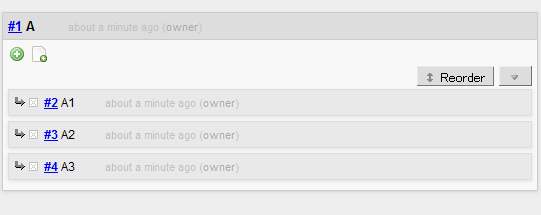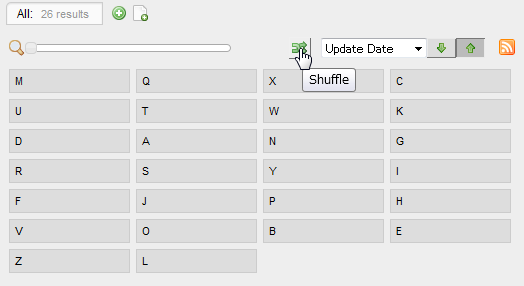Why does Piggydb make your note-taking stand out from the crowd?
Posted: March 16, 2013 Filed under: essay 2 CommentsPiggydb changes the way of note-taking.
Note-taking was originally a top-down process. The ancient people started note-taking to record things on important subjects, using it as a device of artificial memory. Naturally, they needed to organize the contents of the memory well enough to be able to use the accumulated knowledge efficiently. But, because of the physical limitations of the old mediums (stone, wood, etc), they had to decide the structure of content in advance. It leads to so-called linear note-taking.
Linear note-taking is a technique where you take notes sequentially in an outline format (tree structure). In physical mediums, such as paper, you have to make an outline (roughly at least) before taking notes in detail since it is difficult to change the outline structure later. So if you want to create a large document, you need to combine linear and non-linear note-taking (free mapping), and evolve the document by rewriting the whole thing iteratively.
As the personal computing era began, there was a huge breakthrough in this area: the emergence of note-taking software. Note-taking software made restructuring notes extremely easy and allowed users to grow a structure by trial and error with virtually no cost.
This kind of note-taking software is typically called an ‘outliner’. Its more visual and free-formed alternative – mind mapping, has also grown popular among note-taking techniques. The common feature of these techniques is that they let you to take tree-structured notes in a top-down manner.
Let’s look at how this “tree and top-down” note-taking technique looks like in Piggydb.
To begin with, you have to select a main topic (A), which becomes the root of the tree you are about to grow. And then, collect subtopics (A1, A2, A3, …) belonging to the main topic:
As you are taking notes, you can add a subtopic to any level of topic to extend the hierarchy:
And later on, you can change the order of any subtopics:
While this “tree and top-down” still seems to be the mainstream of note-taking and other information management techniques, a new trend has emerged in recent years as the amount of information each individual has to deal with increased.
In a tree structure, everything should be well sorted and organized, otherwise you could not find the information you need and when you need it. However, in reality, as the amount and variety of information grows, it becomes more and more difficult to maintain the consistency of the structure and you would end up not organizing it anymore.
As you all know, the technology that has totally changed the situation was search engines. With an effective search engine, you can access the needed piece of information whenever you want as long as you put the whole data into a place where the search engine can access it. This has changed personal information management to a large extent. I believe many of you stopped sorting your emails out when Gmail was introduced, and more generally, manage your information in a personal database such as Evernote.
These technologies have been gradually changing the role of “tree and top-down” so that it is utilized in more limited cases. For example, as a routine, people save incoming daily information to their personal database without sorting it out, and when they want to consider or investigate a certain topic, they search their database for related pieces of information which will become the ingredients of outcome cooked with “tree and top-down” or non-linear note-taking techniques.
It is a quite modern information management and seems to be enough for us to survive in today’s information-oriented world.
However, there is one important area, especially important in today’s world becoming flatter and flatter as a labor market, that these note-taking techniques have not focused on so far.
That is human creativity.
What the traditional note-taking has focused on is, as I mentioned above, extending human memory and efficiently grasping the outline of existing knowledge. But the most important (and interesting) part of intellectual production activities would be the process of discovering unknown concepts from a vast sea of information, not following existing knowledge (yes, it’s still important though).
It is an attempt to restructure the existing system of knowledge.
For most of students who keenly need note-taking, it might be all they could do to follow and absorb existing knowledge. But in order to stand out from the crowd in this digital era where you can get needed information quite easily, you need a technique leading you to the discovery of innovative ideas. That is the bottom-up note-taking Piggydb has proposed.
In bottom-up note-taking, you don’t need to select a main topic. Yet it is quite normal to select a certain topic as a starting point, but you are not bound to be within that area.
You just put incoming pieces of information into your database one by one:
At the beginning, no remarkable structures are visible. But as the number of the fragments grow and you repeatedly review and shuffle them in the various views,
you discover an unexpected commonality across several fragments and create a new fragment representing the commonality:
Then, after commonality fragments accumulate to some extent, you pick one that feels important to you and turn it into a tag,
which distinguishes the fragment from others as a concept and provides you with a more useful base to build knowledge of the newborn concept.
That’s a brief introduction to the bottom-up note-taking in Piggydb.
With only “tree and top-down” and a remember-everything-type-of-database, it would not be easy for you to doubt the structure/premises behind the topic you have selected in the first place. These techniques would be good enough to grasp the structure of the cave you are exploring, but not suitable for searching for hidden treasures.
If you are practicing bottom-up note-taking, everyday will be filled with new discoveries. You will arrive at an unexpected destination (in a good sense, of course) and acquire your own thought framework.
Anyway, the best way to understand it is to try it out and experiment yourself. Piggydb is extremely easy to get started, so download the latest version from here and start your journey of knowledge creation right away.










[…] Why does Piggydb make your note-taking stand out from the crowd? | Piggydb […]
Though I really like the idea of bottom-up organization of thought, I doubt anyone would really use piggydb the way it is described here.
First of all: Even with piggydb, the amount of notes becomes unmanageable as soon as it surpasses a few dozen on the same topic. Which basically means that I need to make a decision on note category, _before_ I take a note; I need to tag similar notes to find them and get them organized later.
Also: I can’t see the point of organizing the notes in hierarchies as a first step based on commonalities, and make the commonality a tag afterwards. Actually my process is the exact opposite. I’m trying to find commonalities as a first step – that’s fine – but after that I mark these with a tag, and don’t try to put them in a hierarchy. Once I find enough overlapping commonalities in a set of ideas, I’m trying to analize their relations by playing around with tag-based filtering, to see what lies in the intersection of ideas, what if i subract one commonality from another, etc. And once that’s also done, I’m starting to build up a hierarchy, based on what I learned by studying the tag structure.
The problem with assigning a hierarchy first, is that it makes seeing patterns (i.e. filtering) nigh impossible. Supposing I’m building a database on animals, then – based on the above description – I’d have a commonality called “Land animals” with dog and cat in it, and “Furry animals” with whale, dog and cat in it. If I put these in hierarchies in the first place, I can’t see a way to find furry land animals unless i turn my commonalities into a tag _and_ destroy these previously built hierarches _and_ assign the tag to each child in the destroyed hierarchy.
Wouldn’t it be simpler to skip the hierarchy part and start with tagging in the first place? If a tag is meaningful in itself, one can add the descriptive hierarchy later on at any time.
Not to mention that the above process suggests that any tags can have a hierarchy assigned to, which is simply not true. There are status tags, and tags, which are mere attributes of a bunch of other tags – these are all legitimate uses of a tag and none of these arises from the hiearchy step described above.
What I’d love to see is some further explanation on what you do, once you’ve turned a given hierarchy into a tag. How do you use that tag in the database later on?